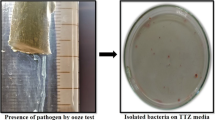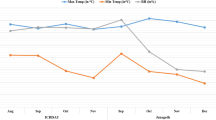Abstract
The response of 11 onion cultivars (Allium cepa, L.) grown in flats containing soil infested withPyrenochaeta terrestris, the causal agent of pink root disease, was studied. In addition, four cultivars were tested in field trials. Pink roots were found on all the cultivars, including those considered to be resistant. The cultivars ‘Golden’ and ‘Yellow Creole’ were highly susceptible to pink root, whereas cvs. ‘Dessex’, ‘Granex’, ‘Laredo’, ‘Grano 502’ and ‘Grano’ (local) managed to grow and produce reasonable yields, despite having infected roots. Following infection, the growth period of early and intermediate maturing cultivars was shortened by 4–14 days, and that of late maturing cultivars by 18–45 days. A large percentage of small bulbs was produced by most of the susceptible cultivars, but no consistent results were obtained with the resistant cvs. ‘Granex’, ‘Dessex’, and ‘Laredo’. The resistant cultivars maintained an, extensive and viable root system which enabled them to tolerate the disease when grown in infested soils.
Similar content being viewed by others
References
Gorenz, A.M., Walker, J.C. and Larson, R.H. (1948) Morphology and taxonomy of the onion pink-root fungus.Phytopathology 38:831–840.
Jones, H.A. and Mann, L.K. (1963) Onions and their Allies. Interscience Publ. Inc., New York, NY.
Katan, J., Rotem, I., Finkel, Y. and Daniel, J. (1980) Solar heating of the soil for the control of pink root and other soilborne diseases in onions.Phytoparasitica 8:39–50.
Krikun, J., Orion, D. and Alon, Y (1979) [Control of nematodes and pink root in onions].Hassadeh 59:1304–1306. (in Hebrew)
National Academy of Science. (1968) Plant Disease Development and Control.U.S. natn. Acad. Sci. Publ. 1596.
Sneh, B., Netzer, D. and Krikun, J. (1974) Isolation and identification ofPyrenochaeta terrestris, from soil on dilution plates.Phytopathology 64:275–276.
Stevenson, F.J. and Jones, H.A. (1953) Some sources of resistance in crop plants.in: Plant Diseases.Yb. Agric. U.S. Dep. Agric. 1953:192–216.
Vaughan, E.K. and Siemer, S.R. (1971) Soil fumigation for onion pink root.Down to Earth 26:14.
Walker, J.C. (1952) Diseases of vegetable Crops. McGraw-Hill, New York, NY.
Walker, J.C. (1953) Hazards to onions in many areas.in: Plant Diseases.Yb. Agric. U.S. Dep. Agric. 1953:431–434.
Author information
Authors and Affiliations
Additional information
Publication of the Agricultural Research Organization. No. 312-E, 1980 series.
Rights and permissions
About this article
Cite this article
Levy, D., Gornik, A. Tolerance of onions (Allium cepa L.) to the pink root disease caused byPyrenochaeta terrestris . Phytoparasitica 9, 51–57 (1981). https://doi.org/10.1007/BF03158329
Received:
Revised:
Issue Date:
DOI: https://doi.org/10.1007/BF03158329




